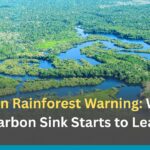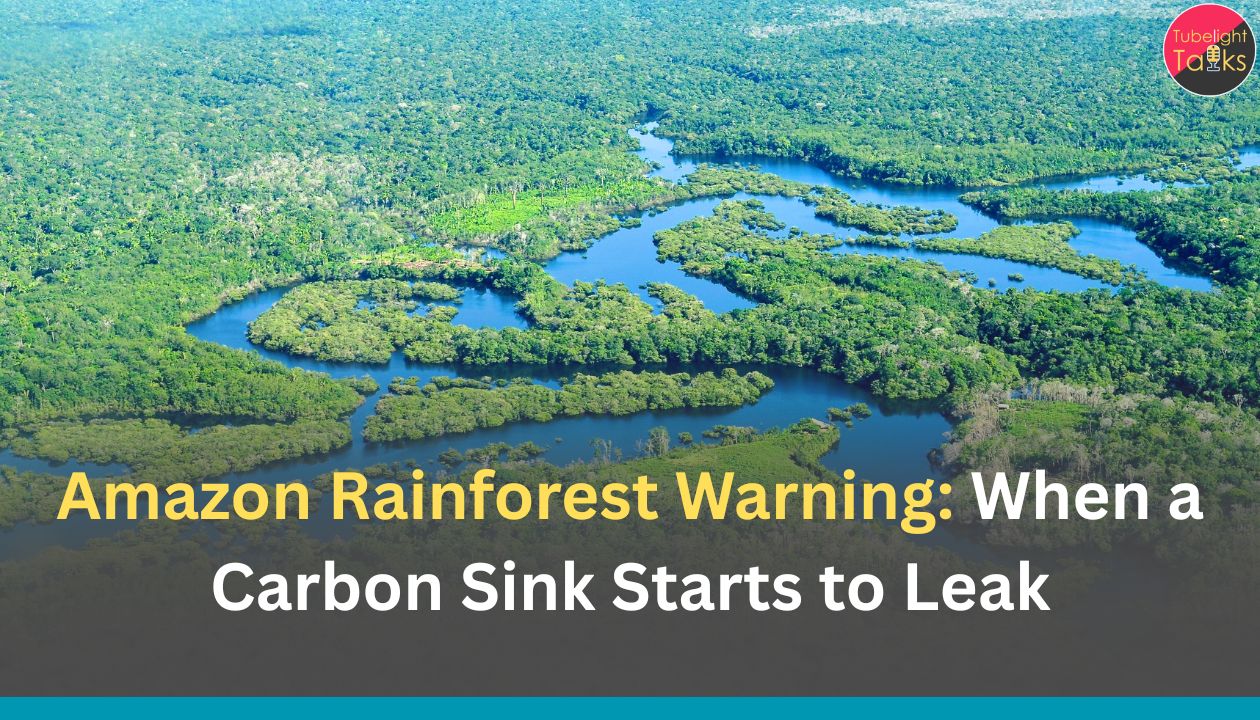Amazon Rainforest Warning: The Amazon Rainforest has long buffered the planet by soaking up carbon dioxide. But research shows that balance is breaking in parts of the forest—especially its deforested and degraded south-eastern stretches. Landmark aircraft observations first demonstrated in 2021 that southeastern Amazonia acts as a net carbon source, with fires and warming drying trends tipping the balance.
In 2024, the region suffered its most devastating fire season in over two decades, driving record CO₂ emissions from Amazon fires; 2025 has seen deforestation decline further, yet fire risk and degradation still threaten the carbon budget and biodiversity.
The Trigger: Why It Matters
In parts of the Amazon, trees now emit more CO₂ than they absorb due to deforestation and degradation, and the world should treat this as an alarm bell. A BBC post here (Hindi):
The underlying point is correct and consequential: if a major tropical forest shifts from sink to source, global pathways to 1.5–2°C become much harder, forcing faster energy decarbonisation and stronger nature protection to compensate.
What the Science Says (and Since When)
A 2010–2018 reality check from the sky
A seminal Nature paper (Gatti et al., 2021) used aircraft to sample air columns over the Amazon and found total carbon emissions are higher in the east than west, with southeastern Amazonia acting as a net carbon source even before accounting for large fires. The authors linked this to deforestation, fire, and warming-driven drying, making regrowth and absorption weaker.
Global bodies took note
The World Meteorological Organization highlighted the same finding: the Amazon’s carbon sink is in decline due to deforestation and climate change. In other words, the forest’s role as a planetary buffer can’t be taken for granted.
2024–2025: Fires, drought and a stressed sink
New assessments report unprecedented Amazon fire emissions in 2024, with an EU Joint Research Centre analysis estimating ~791 million tonnes CO₂ released—roughly the annual emissions of Germany—a sevenfold jump versus the average of the prior two years. Independent reporting notes that fire emissions in 2024 surpassed emissions from deforestation for the first time on record, underscoring the role of climate-amplified drought and degraded forests in fueling extreme burning.
Isn’t Deforestation Falling? The 2025 Paradox Explained
Yes: Clear progress on cutting forest clearing
Brazil’s official systems (INPE/PRODES) and government communications show deforestation in the Brazilian Amazon fell ~30.6% in 2024 to around 6,288 km²—the lowest in nine years—continuing declines under President Lula’s enforcement push. In 2025, deforestation fell further year-on-year into the July cycle, even as Brazil prepared to host COP30 in Belém with a pledge of zero deforestation by 2030.
But: Fires and degradation can still flip the carbon math
Despite deforestation gains, 2025 fire detections remained elevated in many months, and scientists emphasize that degraded forests—logged, fragmented, or repeatedly burned—store and cycle less carbon and are more fire-prone. Analyses show burned areas and forest degradation were exceptionally high in 2024, with Biogeosciences (2025) documenting the worst disturbance in over two decades, and 2025 field season data showing large, though reduced, burned area vs 2024. Conclusion: cutting clear-cutting is necessary but not sufficient; you must dampen fires and restore degraded tracts to recover sink strength.
Why Do Forests Flip From Sink to Source?
Deforestation and edge effects (the slow leak)
When clearing creates hot, dry edges, trees suffer more stress and mortality. Add roads and fragmentation, and you get chronic emissions from decay and recurring fire. Over time, net carbon uptake weakens and may reverse.
Droughts and heat (the hammer)
Warming in the Amazon basin increases the frequency and intensity of droughts, limiting photosynthesis and raising tree mortality. Multiple syntheses document weakening land carbon sinks during drought/fire years, with the Amazon a prime concern since 2015 and especially in 2023–2024.
Fires (the shock)
Fire emissions are immediate and massive, but post-fire degradation can persist, turning landscapes into net sources for years. This is what 2024 underlined: a spike in combustion plus long tail of degradation.
Are We Near a Tipping Point?
Scientists debate precise thresholds, but multiple lines of evidence suggest parts of the Amazon—especially the southeast—are dangerously close to long-term shift risks (savannization patches, hydrological feedbacks). The Nature study and subsequent expert commentary warn that continued warming + deforestation + fires could lock in a regional carbon source. Curbing all three drivers is central to avoiding that scenario.
Brazil’s Current Pledges and Progress
Enforcement and targets
Brazil has reduced Amazon deforestation sharply since 2023, beefed up satellite monitoring and federal enforcement, and recommitted to zero deforestation by 2030 ahead of COP30. Official updates highlight declining clearing, though authorities acknowledge fire management remains a challenge under severe drought conditions.
What 2025 data imply
Even with deforestation down ~11% (Aug 2024–Jul 2025), fires surged in the early-to-mid 2025 period before easing late in the dry season, reflecting climate variability and legacy fuel loads. Policy takeaway: keep deforestation drops going, expand fire prevention & rapid response, and restore degraded forests to rebuild the sink.
What This Means for the World’s Carbon Budget
The Global Carbon Project (2025) projects record fossil CO₂ emissions this year, widening the gap to 1.5°C. If the Amazon’s sink is weakening while fossil emissions rise, the remaining carbon budget shrinks faster, demanding deeper energy cuts and nature-based removals. Protecting and restoring the Amazon is not charity it’s budget math for Paris goals.
What Must Happen Next (Action Agenda)
Protect, Prevent, Restore—Three Ps to steady the carbon sink
Protect (no-deforestation and anti-degradation law in action)
Sustain and expand Brazil’s enforcement surge, close illegal road frontiers, and strengthen land tenure—especially for Indigenous territories that consistently show lower deforestation. International partners should fund verified protection rather than only promise offsets. (Context from official Brazil updates and datasets cited above.)
Prevent (fire & drought risk management)
Scale early-warning systems, fire bans during severe droughts, and community fire brigades; invest in mosaic fuel breaks around settlements and critical biodiversity refuges. The 2024 fires demonstrate that fire seasons can erase multiple years of deforestation gains in climate terms.
Restore (heal degraded edges and reconnect fragments)
Direct climate finance to reforestation of edges, assisted natural regeneration, and canopy connectivity corridors. Recovery of humidity recycling and local rainfall depends on contiguous canopy; restoration is a carbon and water strategy. (Backed by the degradation/fires literature and Nature 2021 findings.)
Clean Supply Chains
Zero-deforestation commodities
Scale public + private traceability for beef, soy, timber with transaction-level audits and jurisdictional performance (counties rewarded for verified low risk). Rich-market buyers must exclude leakage and invest in producer transitions.
Data, MRV and Accountability
One map, many uses
Fuse INPE (deforestation), fire detections, degradation maps, and carbon flux estimates into a public MRV layer that guides federal action and donor payments. COP30 is the moment to lock this in.
Shared Stewardship: A Values Lens on Living Gently with Nature
A liveable climate requires restraint, truthfulness, and care—virtues echoed in many spiritual teachings. Contemporary discourses by Sant Rampal Ji Maharaj often emphasise non-violence, ethical conduct, and self-discipline principles that translate into compassionate consumption, honest supply chains, and service to the vulnerable (including communities who protect forests).
Choosing fair, deforestation-free products, limiting waste, and supporting truthful, law-abiding governance align spiritual values with ecological outcomes. Explore these perspectives through his official resources and talks to ground climate action in daily conduct.
Call to Action
From Alarm to Action
For governments (Brazil + partners)
- Lock in zero deforestation by 2030 with stable funding and result-based payments that also reward fire prevention and restoration.
- Expand brigades & early-warning capacity for drought-intensified fire seasons; prosecute illegal clearing and arson swiftly.
For companies and investors
- Implement traceable, zero-deforestation supply chains for beef/soy/timber with independent verification; support producer transitions rather than just banning.
- Align portfolios with science-based targets, recognising that Amazon sink loss narrows the global carbon budget.
For citizens
- Reduce high-impact consumption (food waste, unnecessary red-meat demand), choose deforestation-free labels, and support watchdogs reporting illegal clearing and fires.
- Share verified posts (like BBC Hindi’s) and avoid misinformation; link to official datasets and peer-reviewed science.
Also Read: Climate Tipping Point Crossed: Global Coral Reefs Face Irreversible Collapse, Warn Scientists
FAQs: Amazon Rainforest Warning Alarm
1) Is the entire Amazon now a carbon source?
No. The southeastern Amazon has been documented as a net source; the basin as a whole remains variable by season and region. The trend is worrying because fires, drought and degradation weaken the overall sink.
2) If deforestation is falling, why are emissions rising?
Because fires and degradation can spike emissions even when new clear-cutting declines. 2024’s fires delivered record CO₂; 2025 saw lower deforestation but still elevated fire risk under drought.
3) What has Brazil pledged?
Zero deforestation by 2030, with stronger enforcement and satellite monitoring; COP30 in Belém keeps pressure and support focused on delivering those goals.
4) What would “success” look like for the carbon sink?
Sustained near-zero deforestation, sharp reductions in fire, and mass restoration of degraded edges and fragments—measured by stable or rising net CO₂ uptake using independent MRV.
5) How does this affect the global carbon budget?
With fossil CO₂ at record highs in 2025, losing the Amazon sink accelerates budget exhaustion—forcing faster energy cuts and more removals elsewhere.










